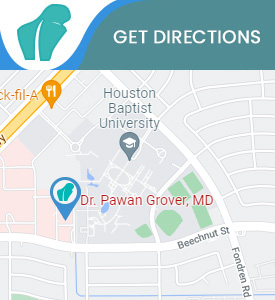Essential Questions to Ask Myofascial Pain Therapist in Houston, TX
Myofascial pain syndrome is a condition where pain spreads to seemingly unrelated body areas from pressure on sensitive points in the muscles. Overuse of the muscles or recurrent injuries are common causes of the syndrome. Dr. Pawan Grover, MDPA at InovoSpine offers myofascial pain therapy to ease your pain and increase the range of motion. For more information, contact us or book an online appointment. We serve patients from Houston, TX and surrounding areas.




Table of Contents:
Myofascial pain overview
What are the causes of myofascial nerve pain?
What are the symptoms of of myofascial nerve pain?
What does a myofascial therapist do?
What are myofascial trigger points?
What is the difference between myofascial release and massage?
Can a chiropractor help with myofascial pain syndrome?
Myofascial pain overview
Myofascial pain is a chronic condition that affects the connective tissue that covers the muscles. It can occur in one muscle at a time or in a muscle group.
This neuromuscular disorder causes trigger points to develop that are tender to the touch and can prevent the use of a muscle. The trigger points become painful when a muscle is strained, injured, or fatigued.
Myofascial pain usually develops from a muscle injury, excessive strain to a particular muscle, repetitive motions from work or daily activities or lack of movement.
The symptoms of this disorder usually cause the patient to feel pain and discomfort. The symptoms are muscle weakness, tingling, stiffness, aching pain in certain muscles, and difficulty sleeping because of the pain.
Myofascial pain syndrome is more than muscle discomfort. It is caused by restrictions in the myofascial tissues. Myofascial pain syndrome can continue to bother you after the known cause has passed, or get worse over time.
The fascia is the thin connective tissue that supports much of your body and creates an uninterrupted web all over the body. It absorbs shock and helps the muscles move. The fascia can accumulate trauma from various injuries and damage to repetitive movements and chronic conditions.
Myofascial release therapy is a noninvasive therapeutic approach to treating myofascial pain syndrome. It is a hands-on method to relax, realign and lengthen your fascia. The goal is to reduce pain and increase the range of motion.
A trained therapist will do a full assessment of your muscles and movement. Healthy fascia will feel malleable and elastic. Areas of the fascia that are holding pain and trauma will feel stiff and tight. Areas that are stiff and tight are trigger points and could be the source of your pain. These points may not be where you feel pain.
Using light pressure, the therapist will massage and stretch trigger points. They may hold that point for a few minutes to release the tension. They may repeat this action at each trigger point until they feel a complete release.
Myofascial pain syndrome is a chronic pain problem that affects the muscle system of the body. People who suffer from this will have sensitive spots that are known as trigger points. These locations develop tight, ropey bands of muscles and when pressure is applied there is pain.
There are two primary types of trigger points, primary and secondary. Primary trigger points happen in one muscle and can restrict proper muscle movement. If this is left untreated, other muscles can compensate to find ways to move around the primary injury. This compensating action can cause secondary trigger points in other muscles.
These trigger points can be broken down into more specific types. Active trigger points are primary trigger points and are the ones that cause referred pain in other locations. Latent trigger points do not cause pain when they are touched and can remain dormant for years. They can become active if there is trauma or stress. Secondary trigger points are painful points in other muscles that are not the primary point of pain. Satellite myofascial points are painful spots that activate because it is located at another trigger point.
Myofascial release therapy differs from massage because they each have a different focus. Massage works on the soft tissues and muscles of the body to relieve tension and stress. Myofascial release works on the connective tissue to relieve the tightness that causes muscle restrictions. The type of touch in each therapy is different. Massage uses a steady movement, like stroking or kneading to relax the muscles. Myofascial release uses continuous pressure to lengthen and stretch the fascia.
Chiropractors can help with myofascial pain syndrome. Chiropractors are good at finding trigger points which they can accomplish with a variety of techniques. Sometimes the best treatment for myofascial pain is to apply pressure to the trigger points. Chiropractors are able to do this with their hands and the tools that they have available.
Since the cause of myofascial pain is often the result of trauma, this trauma may not be easily identified. Misalignment of muscles and skeleton can cause the body to move improperly, which creates strain and pain. Getting things aligned again can help reduce muscle pain and prevent future problems. Dr. Pawan Grover is an interventional pain doctor. He specializes in the treatment of pain in the back and spine and other parts of the body with minimally invasive procedures. For more information, please contact InvoSpine to make an appointment. Or you can use the online appointment system. We serve patients from Houston TX, Hedwig Village TX, Meadows Place TX, Missouri City TX, Hunters Creek Village TX, Spring Valley Village TX and surrounding areas.

Additional Service You May Need
- Regenerative Medicine
- Spinal Arthritis
- Diagnostic Mapping
- Interventional Pain
- Minimally Invasive
- Spine Pain
- Radiofrequency Ablation
- Spinal Cord Stimulation
- Physical Rehabilitation
- Facet Joint Pain
- Herniated Discs
- Muscle and Joint Pain
- Post-Laminectomy Pain
- Myofascial Pain
- Peripheral Nerve Pain
- Regional Pain Syndrome









